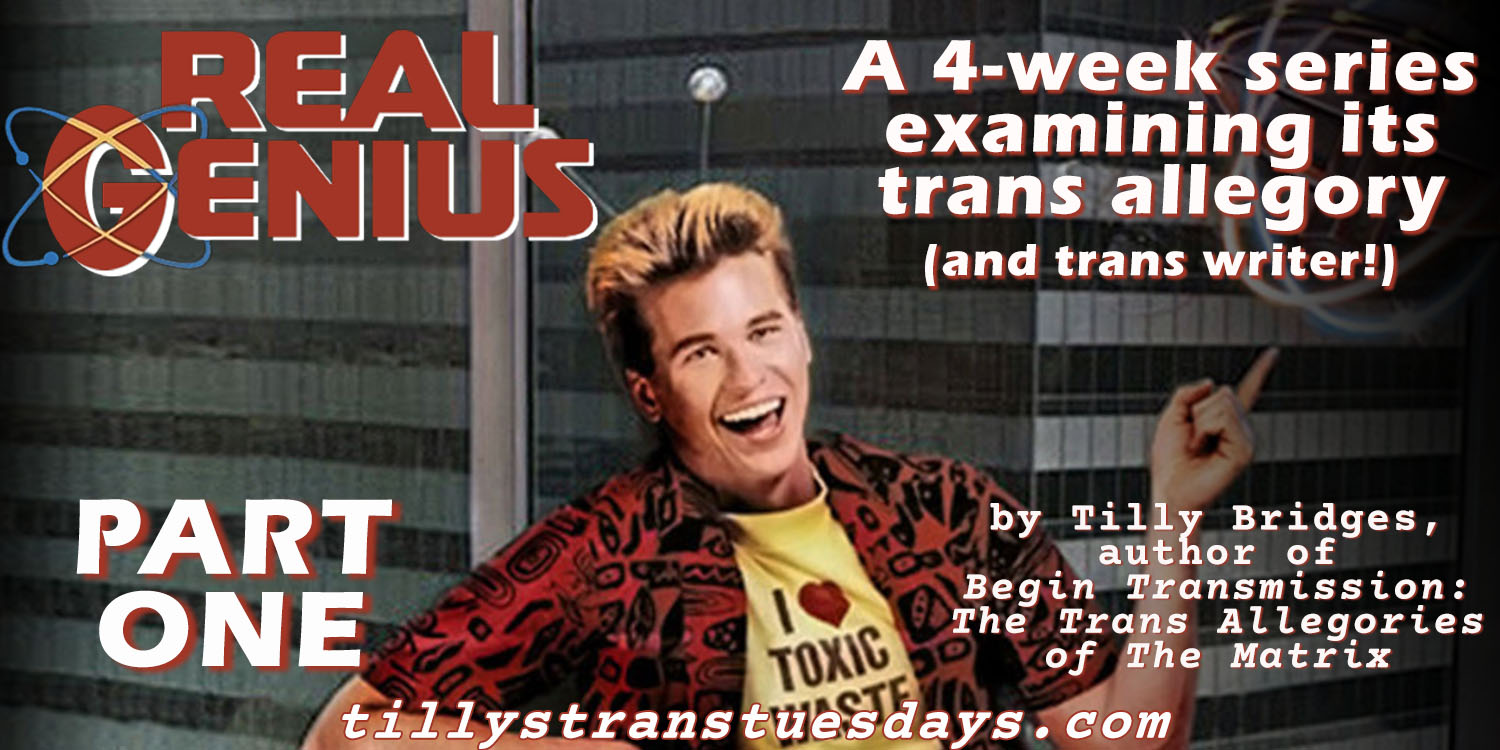Welcome to Trans Tuesday! Today we’re going to dive into another movie with an incredible trans allegory that says something truly wonderful about trans folks. We’re starting THE INTENTIONAL TRANS ALLEGORY OF REAL GENIUS, part 1 – CONTEXT AND SCREENWRITER PJ TOROKVEI.
I had somehow managed to never see this movie for my entire life until watching it to do this writeup. I don’t know how that happened, I wasn’t trying to avoid it or anything! But Jennifer Kramer, a trans friend of mine, mentioned to me that she thought I should do an examination of its trans allegory.
This of course piqued my interest, especially when learning that one of the three credited writers was a trans woman. So I watched it, and there is definitely a trans allegory at play and we’re gonna talk about it. But we have to talk about a few other things first.
A trans woman screenwriter! I mean talk about my wheelhouse, that’s me. And here’s a movie written by one of us from the 80s! But Hollywood is complicated, and so is trying to learn about trans people who existed in the past, despite the fact that we have always existed and always will, for reasons I talked about in TRANS HISTORY 1: HOW AND WHY WE NAME TRANS PEOPLE IN HISTORY.
We ARE going to go through the movie by timestamps, just like in my deep-dives on the MATRIX, BARBIE, I SAW THE TV GLOW, and NERVOUS MAN, and I know that’s likely what you’re all anxious for. So I want to mention that won’t start until part 2 next week, because there’s vital context we have to talk about first.
You don’t have to have read my book to understand the trans allegory of Real Genius, but I will call back to the Matrix allegories multiple times because, surprise surprise, different trans allegories are still trans allegories and thus have much in common. And the Matrix is the platonic ideal as far as trans allegories go.
Now it’s common for movies to have multiple writers across multiple drafts. The Writer’s Guild has rules for who gets credited and how, but not every writer that works on a movie’s script always gets credited.
It’s also common for script changes to happen during shooting, for the director to adjust things, etc etc. There’s no way to know how much of what made it to the shooting script and then ended up in the movie was from the trans woman writer’s contributions.
So there are other voices mixed in with hers, and she didn’t direct it. This is not a case of a pure vision like with the Wachowskis and the Matrix movies or Jane Schoenbrun and I Saw the TV Glow. This is one trans voice amid a sea of cis voices, all contributing to the final product.
I see trans metaphors and an overall allegory in Real Genius, and some parts we can almost be entirely sure came from the trans woman writer based on how very trans they read, but there’s no way to know exactly what came from who without someone who worked on it to tell us.
The trans woman credited as one of the writers on Real Genius is PJ Torokvei. She worked with Second City, wrote a handful of movies, and was showrunner of WKRP in Cincinnati for a while. But all of it was under her deadname. Once she transitioned, she had no further credits that I could find.
I don’t know if that’s because she chose to retire from screenwriting, or because of discrimination she faced after coming out. I certainly hope it’s the former, but the transphobic world we live in (doubly so back then) makes me fear it was the latter.
She came out in 2001 and died in 2013 from liver failure. Some second-hand information I found suggested her death may have been from complications from her medical transition, which is awful to think about. The thing that eases your pain being what kills you is just… horrific. But there’s also this thing we call “trans broken arm syndrome,” where you could go to the doctor for a broken arm and they’d blame it on us being trans somehow. This happens a lot with cis doctors. So the true cause of her medical issues is just not something we have details on.
Also note that when PJ transitioned, WPATH (World Professional Association for Transgender Health) would have likely been on version 5, possibly 6 depending on the timing of when she began. While not as horrific as version 1 was, it still classified being trans as a “mental disorder” and there were a lot of problems with it. You can read a little bit more about the specific issues with those versions here.
To see where it all began, see the essay on TRANSMEDICALISM (and WPATH version 1), to truly understand what horrific bullshit trans people who wanted to medically transition in the recent past had to deal with.
I was able to find and speak with someone who worked with her (though not on Real Genius), and I’ll include some of his thoughts shortly. But first I want to talk about a secondhand account of PJ from a friend of hers, Stan Brooks, in a letter written and published in the Hollywood Reporter after her death. That’s as close as we can get to hard facts, but some of it is relevant.
I’m going to quote some important parts, but if you go to read the article, be aware it routinely deadnames and misgenders her (in an article written by her close friend!), and includes pre-transition photos of her. It was painful for me to read.
It happens out of ignorance and not malice, as far as I can tell, but note that even when it was written (in 2013) trans people had so little cultural footprint that in a letter from a personal friend about our death, deadnaming and misgendering was still rampant. For the portions I’m quoting, I will be using her correct pronouns and real name.
Stan Brooks says PJ sent a letter to friends/family coming out on her 50th birthday. Part of it read, “… [she] was choosing to go public with the secret that [she’d] always felt trapped — as a female in a man’s body — and that [she] planned to have surgery to change [her] sex.”
In the letter, PJ also confessed fears over losing friends, family, and her career. PJ was forced to “live as a woman” for a year before any kind of medical intervention would be allowed, which almost assures that she was under WPATH version 5, as that bit of transphobic bullshit was still a requirement.
Imagine being forced to live a year adhering to someone else’s idea of what a woman is or should be just for the right to access the lifesaving medical care you need. CAN YOU IMAGINE? It’s pretty horrific.
Stan asked her, “‘Why not just be gay and come out of the closet?’ [PJ’s] answer was all too obvious and drove home [her] anguish.”
PJ’s reply: “If only it was that easy. I wish I could do that. I’m not a man. I’m not attracted to gay men. No more than heterosexual women are attracted to them.”
Imagine some of your closest friends asking why you don’t just be a more “acceptable” form of queer, and the complete lack of understanding of what it means to be trans, being the reply you get. Again, it’s from a place of ignorance and not malice, but it’s still painful.
“Some of PJ’s friends from the Second City days and family members had turned their backs on her during this transition. Some never called again after reading the 50th birthday letter.” Fuck. Heartbreaking. And sadly all too common.
The letter says there were serious complications from her gender confirmation surgery which kept her going back to the hospital, and may have eventually also contributed to her death. But again, “trans broken arm syndrome” is real, so who knows.
As part of my research for this, I contacted writer Ian Boothby, who worked with PJ for a while, to see if I could get a little more info about what she was like. I’m going to include all of it, because there is so little information about PJ out there. I want to preserve as much of her legacy as possible.
Tilly Bridges: Can you tell me a little bit about how you first met PJ, and what it was like working with her? What was her personality like?
Ian Boothby: BC Film, a Canadian government program, had a competition to write a sitcom, and I along with Christine Lippa and Dean Haglund (from the X-Files) wrote a pilot called Channel 92 about a failing sports channel that gets rebranded as a women’s network.
One of the very masculine/sexist hosts has to adapt to their place in this new environment. It starred Gary Jones and Teryl Rothery (from Stargate SG-1) and Ellie Harvie (The New Addams Family).
PJ was still writing under her previous name and was brought in as our comedy consultant and expert on all things sitcom, having been one of the head writers for WKRP.
We hit it off right away. I think we all had background in improvisation and that gave our sessions together a playfulness with the goal to be to build on each other’s ideas.
Looking back the concept of a station evolving from a masculine to feminine energy has some symbolism.
She was sharp, very quick and filled with useful stories that lead us in the right direction. We were all SCTV fans and so were starstruck by someone who had worked on the show.
We do a lot of movies and tv shows in British Columbia but very little on our own, and PJ made what seemed like the impossible possible, by showing us the structure of the sitcom while still giving us enough room to have our own identity.
TB: Did you have any indication she might have been trans, or was unhappy during her time pre-transition?
IB: There was a lot of laughter in our times working together, but that doesn’t always mean happiness. I wouldn’t want to project. A few years later, after she transitioned we visited her at her home in LA and it was great catching up. She had the largest TV we had ever seen, embedded in a wall in a room filled with boxes, because it was too big to actually watch.
It was inspiring seeing someone live the LA writer life. …there was a lot of joy when we caught up.
TB: Did she ever talk about Real Genius or her time writing it?
IB: I know she was proud of it. At the time I enjoyed it and told her so. I do like that it’s one of the rare 1980s comedies that doesn’t feel exploitative of women, even though there are scenes which could easily have gone that way. Also no homophobia, which for an 80s comedy is very rare. PJ and the other writers made a very funny film celebrating intelligence and friendship while going after the right targets.
TB: After she came out as trans, she seems to have not worked in tv or film again. Do you know if that was by choice, or perhaps due to lack of opportunity for trans people? I know she was rejected by a lot of folks when she came out (which is sadly all too common for us).
IB: I’m sorry to hear she didn’t write much later on, she seemed quite well off and I assumed she retired. But that was just a guess and I didn’t want to be nosey.
TB: I wanted to include a photo of her with my write up, but I only found one that was reportedly post-transition, and couldn’t find confirmation that it was actually her. Can you tell if this is her?

IB: I’ve seen that picture online but that’s it. I couldn’t tell you personally if it’s her. It looks close to how she looked the last time I saw her.
Thanks so much to Ian Boothby for taking the time to give us a little more context about a trailblazing trans woman screenwriter, especially because now we know some vital information that we didn’t before.
We know that PJ was happy with how Real Genius came out, which isn’t always the case when there are multiple writers and a director who also change things around. I think it’s safe to assume that she believed most of what she was trying to do came through (I certainly saw it, and you will too, starting next week).
But more importantly, we know that in the little time she had left post-transition, she was happy. Even if complications from transition contributed to her death, even if rejected by far too many people who should have loved her for who she really was, she lived a happy and joyous life. It’s a bright beam of sunlight in the darkness.
Real Genius was released in 1985, meaning it was written somewhere in the years prior, given the generally slow-moving pipeline of Hollywood movies. We don’t know exactly when it was written, or when PJ worked on it, but it was likely somewhere in the early 80s.
Regardless of how she presented at the time, or her friends, family, and the entire world thinking she was a cisgender man, we know that she knew she was trans, and was very aware of why she had to stay in the closet for so long.
If you’re trans you’ve always been trans. And via the aforementioned article about her death, she knew she was a woman regardless of when she began transitioning. Transitioning isn’t what makes you trans, it’s what alleviates and addresses the problem of living as the wrong gender.
So given what we do know, and what you’re going to see through the rest of these essays, I feel comfortable saying the pieces of trans allegory that made it into the final version of the movie were absolutely intentional on her part.
Note that doesn’t always mean consciously intentional. I’ve said many times how in my own past writing I can now clearly see I was working through my own complicated thoughts and feelings about gender, without even consciously knowing that’s what I was doing at the time. That doesn’t mean I didn’t intend to do that, I absolutely did. I just didn’t recognize the meaning behind it at the time.
But a lot of it was very much consciously intentional, I think. It’s all hidden under metaphor, but that’s the only way she could talk about being trans in a movie in the 1980s. Especially when it’s not about the harmful tropes of us being jokes to be mocked, victims of violence, or deceptive sexual predators.
REAL GENIUS IS A CELEBRATION OF TRANSNESS. And now that you’ve got the context, next week we’re going to dive into the movie itself and you’re going to see what being trans meant to PJ, and means to a lot of us.
And how it can change the world.
Tilly Bridges, end transmission.
tillysbridges@gmail.com

